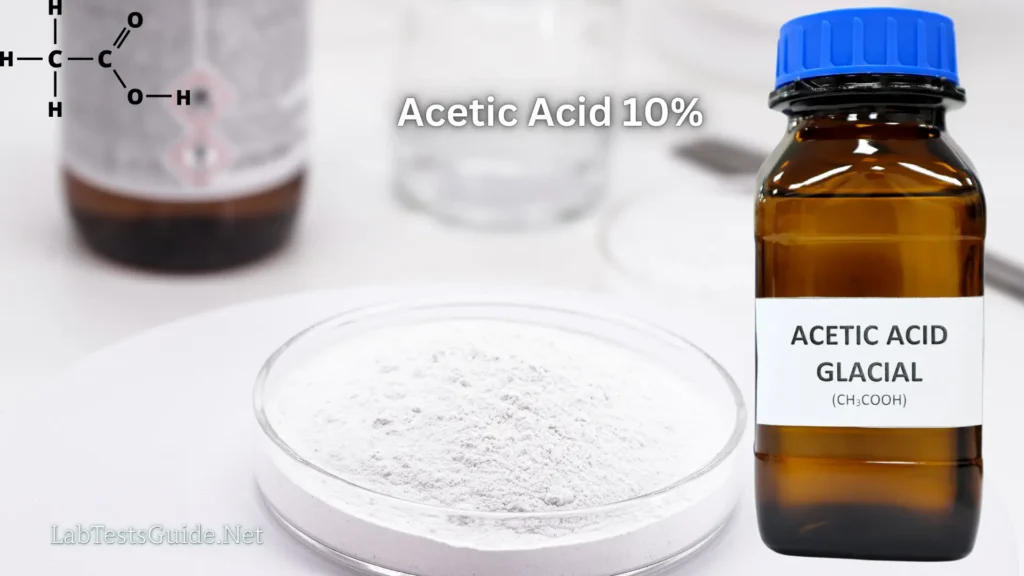Acetic acid 60% is a chemical solution consisting of 99% acetic acid (CAS No.: 64-19-7) and ultrapure water. This solution is widely utilized across various fields including medical diagnostics, histology, metallography, and scientific laboratories. As a weak organic acid (CH₃COOH), acetic acid forms metal acetates and exhibits a range of useful properties. In histology, it serves as a fixative to preserve tissue samples and cell cultures, ensuring the maintenance of structural integrity and morphology. In metallography, it is employed to etch metals and alloys, revealing their microstructure. Additionally, acetic acid is used in scientific laboratories as a reagent and in the preparation of buffer solutions and chemical analyses.

Acetic acid at 60% concentration is used in clinical laboratories primarily for its role as a reagent and for various diagnostic purposes.
Uses of 60% Acetic Acid:
Here’s a concise list of uses for 60% acetic acid in clinical laboratories:
- Staining Enhancement: Improves contrast in staining procedures.
- Histology Fixative: Preserves tissue samples for microscopic analysis.
- Cytogenetics: Prepares cell suspensions and aids in chromosome banding.
- Buffer Solution: Used in preparing buffered solutions and adjusting pH.
Composition of 60% Acetic Acid:
The composition of Acetic Acid (60% solution) typically includes (To make 100 ml):
- Acetic Acid (CH₃COOH), Glacial: 60ml (60% by volume)
- Purified Water/Distilled water (H₂O): 40ml (40% by volume)
Preparation of 10% Acetic Acid:
- Measure Water: Fill a 100 ml graduated cylinder with water up to the 40 ml mark.
- Add Glacial Acetic Acid: Carefully add 60 ml of glacial acetic acid to the cylinder, bringing the total volume to 100 ml.
Caution: Glacial acetic acid is corrosive and emits irritating vapors. Use it in a well-ventilated area and avoid mouth-pipetting. - Mix: Transfer the solution to a leak-proof bottle and mix thoroughly.
- Label and Store: Label the bottle with the solution’s contents and store it at room temperature.
Precautions:
Precautions for Handling Acetic Acid (60% Solution):
- Ventilation: Always work in a well-ventilated area to avoid inhaling vapors.
- Personal Protective Equipment (PPE): Wear appropriate PPE, including gloves, safety goggles, and a lab coat, to protect against spills and splashes.
- Avoid Inhalation: Do not inhale the vapors. Use a fume hood if available.
- Handling: Never use mouth-pipetting. Use appropriate pipetting tools to handle the solution.
- Spill Response: Be prepared to neutralize spills with a suitable neutralizing agent and clean them up immediately.
- Storage: Store in a properly labeled, leak-proof container at room temperature, away from incompatible materials such as strong bases and oxidizers.
- First Aid: In case of contact with skin or eyes, rinse immediately with plenty of water and seek medical attention if necessary. If ingested, do not induce vomiting; seek medical attention immediately.
- Disposal: Dispose of acetic acid waste according to local regulations and guidelines for chemical disposal.
Uses of Acetic Acid (60% Solution) in Clinical Laboratories:
Here are the uses of 60% acetic acid solution in clinical laboratories:
- Histology Fixative: Preserves tissue samples and cell cultures by stabilizing proteins and cellular structures for accurate microscopic examination.
- Cytogenetics:Used in preparing cell suspensions and enhancing chromosome banding techniques for karyotyping and genetic analysis.
- Buffer Solution Preparation:Helps in preparing buffered solutions and adjusting pH levels in various assays.
- Staining Enhancement:Improves the contrast and visibility of cellular components in staining procedures.
- Protein Precipitation:Assists in precipitating proteins from solutions for further analysis or purification.
- Metallography:Employed in etching metal samples to reveal their microstructures and phases.
Possible References Used







